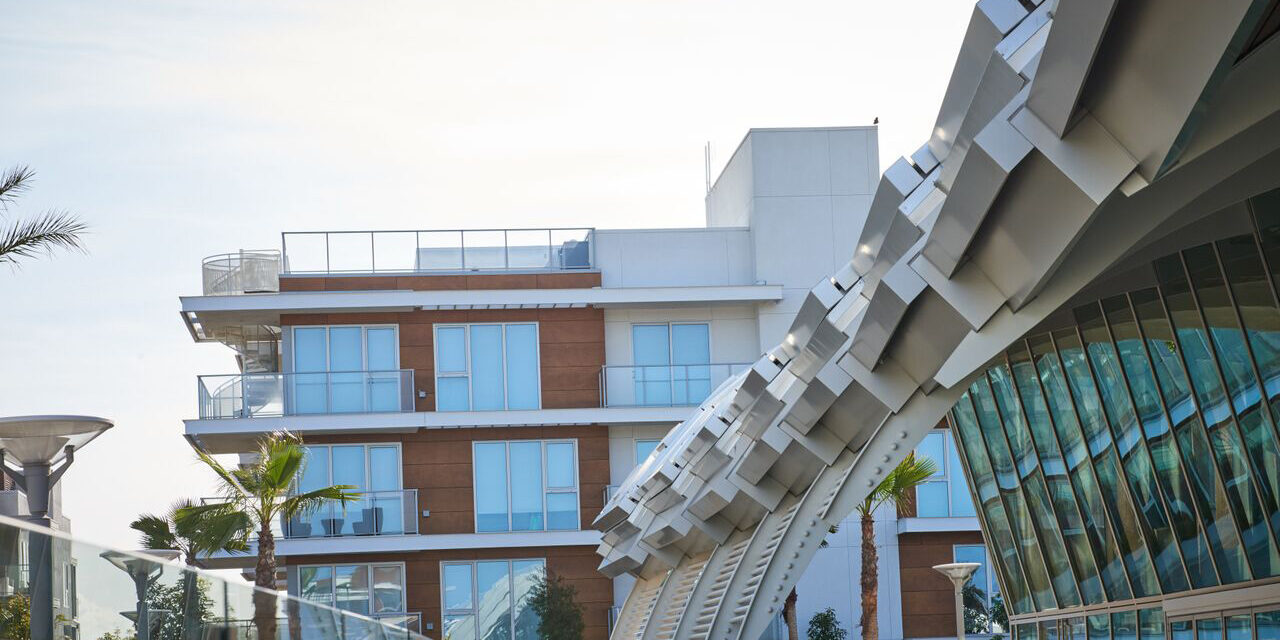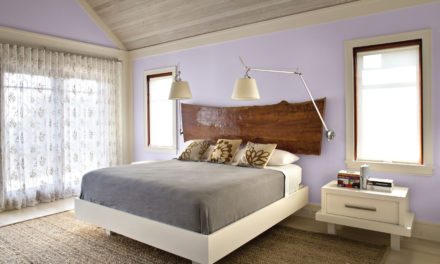High-quality process achieves greater strength, durability, and consistency than paint or batch anodizing
Many quality control issues are faced in architectural aluminum products and other architectural exterior metals. Architectural exterior applications require a material that is very durable, can be colored or finished in unique ways, remains clean and beautiful over time, and delivers other important benefits. With its natural, brilliant look, hard anodic structure, environmentally responsible production, and great ROI, anodized aluminum is an excellent choice for architectural exterior applications when quality control is desired.
Strength and durability
Continuous coil anodizing delivers excellent quality control benefits in terms of the strength and durability of final products. Anodizing is an electrochemical process that grows the aluminum oxide layer from the base aluminum, bonding at the molecular level, so it cannot chalk, chip, flake or peel like coatings or paint. It is actually part of the aluminum, while coatings are a separate material either sprayed or roll coated onto the aluminum. Additionally, coatings often require a separate primer or adhesion promoter to help the material stick to the aluminum.
As a result, anodized aluminum is more durable and lasts longer than most coatings. Aluminum Oxide is part of the Corundum family of gemstones, like a sapphire, and is second only to diamonds in terms of hardness. The hardness of the anodic layer formed in the anodizing process described above makes it very abrasion resistant, outperforming paint in Tabor abrasion and pencil hardness tests. This superior hardness and abrasion-resistance leads to a more durable product.
Paint, on the other hand, does not improve the abrasion resistance of aluminum, but instead hinders it. Because paint is a coating that is either rolled or sprayed onto the base aluminum, it relies on the surface tension it creates with the metal, or a primer, for adhesion. This surface tension can break down over time, causing the paint to lose adhesion, leading to chalking, chipping, flaking and peeling. This loss of adhesion can creep over time, causing more and more of the surface area to lose its paint. Once such paint loss occurs in architectural exterior applications, replacement of the material may be required instead of repainting due to the high costs of labor to sand blast and repaint the original surface.

Aluminum oxide layer grown from the base aluminum after the anodizing process.
With anodized aluminum, if the anodic layer is somehow breached all the way to the raw aluminum underneath, the aluminum will self-heal by creating its own protective oxide layer. This self-healing ensures that any damage will not creep beyond the initial damage point, thus mitigating the need for costly repairs. The anodic layer also resists graffiti and is easy and safe to clean.
The strength and durability of anodized aluminum means that it is a superior product for use in coastal applications. The sapphire hardness of aluminum oxide protects and preserves the aluminum surface from corrosion in harsh weather environments, including coastal areas. Salt spray is pH neutral, so it has little impact on the anodic layer, and the anodic layer’s hardness helps keep the aluminum beneath from being damaged. In comparison, paint can be affected by weather in coastal areas, and paint manufacturers charge extra for a warranty for material used in coastal areas without always changing the formulation of their product.
Finally, even in formed aluminum applications, coil anodized aluminum can be utilized with great success. Any material that is bent or stretched will have micro-fractures along the bend, also known as crazing, because nothing is infinitely flexible. Whether on painted, coated, or anodized aluminum, crazing occurs because the outer side of the bend is stretched more than the inner side. This crazing appears as a frosted effect. While a bent anodized surface may exhibit visible crazing, it is often naturally obscured because of the way light reflects off a bend to create a brighter, frosted look. In the hands of a skilled former, formed anodized parts can be made to look great, and don’t risk cracking and peeling that can spread or creep the way painted formed parts do.
Consistency and coloration
Unlike in other coloration processes, including batch anodizing, the continuous coil anodizing process is able to achieve excellent color consistency. With batch anodizing, individual pieces or panels are lowered into a tank in each part of the process. Inconsistencies in look and color are created because the top of each piece spends less time than the bottom in each step of the process.
With the continuous coil anodizing process, every square inch or millimeter of the entire coil spends the same amount of time in each part of the process. This allows for an unmatched level of consistency, assuring that the colors and finishes look the same throughout all of the coils produced. In addition, the color can be carefully controlled, measured, and recorded so it can be repeated on subsequent orders.
Lorin Industries, Inc. a global leader in the continuous coil anodizing industry offers anodized aluminum in a vast array of colors, with an added ability to custom color match. Lorin can create custom colors, as well as match to almost any color that can be imagined. Lorin also offers a wide variety of UV-stable colors that can mirror or match natural metal looks, including stainless steel, brass, gold, zinc, pewter, bronze, copper, and muntz. Some of these metal looks are also available in pre-patina or antique versions.
While paint is available in many colors, like any organic coating, it will fade over time because it is simply an applied coating, using pigments or dyes that have limited life in terms of color-fastness due to UV rays breaking down the chemicals within the coating. Since the anodized layer in coil anodized aluminum is a part of the aluminum itself, it is not as susceptible to fading.

A painted metal roof chipping, flaking and peeling away.
Beauty and cleanliness over time
As discussed above, the anodic layer of aluminum oxide is a translucent crystalline structure, and this structure enhances the natural metallic beauty of the aluminum beneath. This three-dimensional sapphire crystalline structure reflects and refracts light in unique ways, helping the material come alive in a way that paint cannot match. Paint, as a coating applied to metal, is more one dimensional and flat in appearance. It simply cannot reproduce the natural metallic look of real aluminum, and covers up the natural metal below. Painted aluminum is not metallic to the touch, and cannot be distinguished from any other painted material, resulting in a lack of natural metal feel and visual effect.
Additionally, when each surface is viewed under an electron microscope, the surface of paint appears rough and sloppy compared to the anodic layer of anodized aluminum. The smoother surface of anodized aluminum helps it stay cleaner over time, because dirt, dust and other pollutant materials cannot get trapped on its surface to the same extent as paint.

Electron microscope view of a painted surface.
Unlike the dielectric surface of anodized aluminum, paint does nothing to inhibit the natural static electricity build up on the surface of metals. This can increase the attraction of dust and dirt particles, as well as shock those who touch the surface. As a result, typical paint warranties for architectural building products require a cleaning of the panels on the building every year. Lorin anodized aluminum warranties, meanwhile, recommend cleaning only every other year, providing significant savings on cleaning costs over the life of the building.
Other benefits
Anodized aluminum produced by Lorin Industries has a strong architectural warranty with no restrictions for coastal applications. Lorin provides a minimum 20-year surface warranty that states the material will not chip, flake, or peel, and most UV stable colors available from Lorin also include a 20-year color fade warranty.
Anodized aluminum can be cost-effective compared to other material choices. The cost of clear anodized, per square foot or meter, is comparable to a high quality PVDF paint. For a true bronze, copper, or zinc look, anodized aluminum may be slightly more expensive than paint, but it does not appear flat like paint, and is much more affordable than the natural metals it is replacing. In addition, it lowers cleaning costs over the lifetime of a building, and may provide savings by not requiring re-application like paint.
Coil Anodized Aluminum from Lorin Industries is environmentally responsible in terms of product and process. Anodized aluminum remains pure aluminum, with nothing that can create VOCs or off-gassing. There are no red list items in anodized aluminum, and it meets ROHS standards. Additionally, the anodizing process is environmentally friendly, creating no hazardous waste. The process uses high and low pH chemicals that combine to create an environmentally neutral by-product. Aluminum is one of the only metals that is 100% recyclable, and can be repeatedly recycled through simple re-melting. Paint, in comparison, contains chemicals that include VOCs, which are dangerous to humans, animals, and the environment. Additionally, painted aluminum requires further processing before it can be recycled.
Conclusion
If architectural exterior applications are looking for a material that is very durable, offers a natural metal look, is available in many colors and finishes, is environmentally responsible, can be formed into many shapes or parts, offers a great ROI, and is truly beautiful in unique ways that paint and other coatings cannot match, then anodized aluminum is an excellent solution. Anodized aluminum eliminates many quality control issues faced in other architectural aluminum products.
About the author
 Phil Pearce, Vice President of Global Sales and Marketing, Lorin Industries, Inc.
Phil Pearce, Vice President of Global Sales and Marketing, Lorin Industries, Inc.
With over 37 years of sales and marketing experience, 25 of which he spent focused on the architectural industry, Phil Pearce is the Vice President of Global Sales and Marketing for Lorin Industries, Inc. In this role, Pearce oversees strategic domestic and international sales and marketing for Lorin.
Pearce brings decades of expertise to his work in customer relationship management, market development, project solutions, and product development. Additionally, Pearce oversees the work of a number of teams within Lorin Industries, including sales, distribution, marketing, and customer care. Pearce’s architectural industry and sales expertise contribute greatly to Lorin’s success and customers’ satisfaction.
Lorin Industries, Inc.
Lorin Industries, Inc. has provided coil anodized aluminum to markets worldwide for over 60 years. Our history of global leadership in anodized aluminum finishing for architectural markets began with bringing the process to market in 1953, and continues today with industry leading innovation. Lorin has worked with some of the world’s foremost architects, designers, and fabricators to create new and exciting building designs that last throughout generations.
Whether used for exterior wall cladding systems, roofing systems, sunscreens, interior panels, or decorative interior applications, the possibilities for coil anodized aluminum are infinite. The natural beauty of Lorin’s anodized aluminum finishes brings newly constructed and renovated buildings to life, while providing a strong durable surface that will never chip, flake, or peel. Additionally, Lorin’s coil anodized aluminum products have been used for automotive, transportation, consumer appliances, and any number of other industries, with the same excellent aesthetics and durability long proven in architectural applications. At Lorin, we can help you reflect your vision with Lorin anodized aluminum.
For additional information visit www.lorin.com and follow Lorin on Twitter, Facebook, and LinkedIn.




